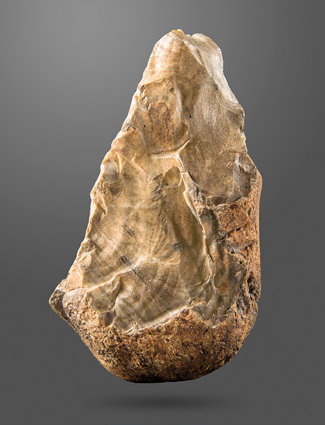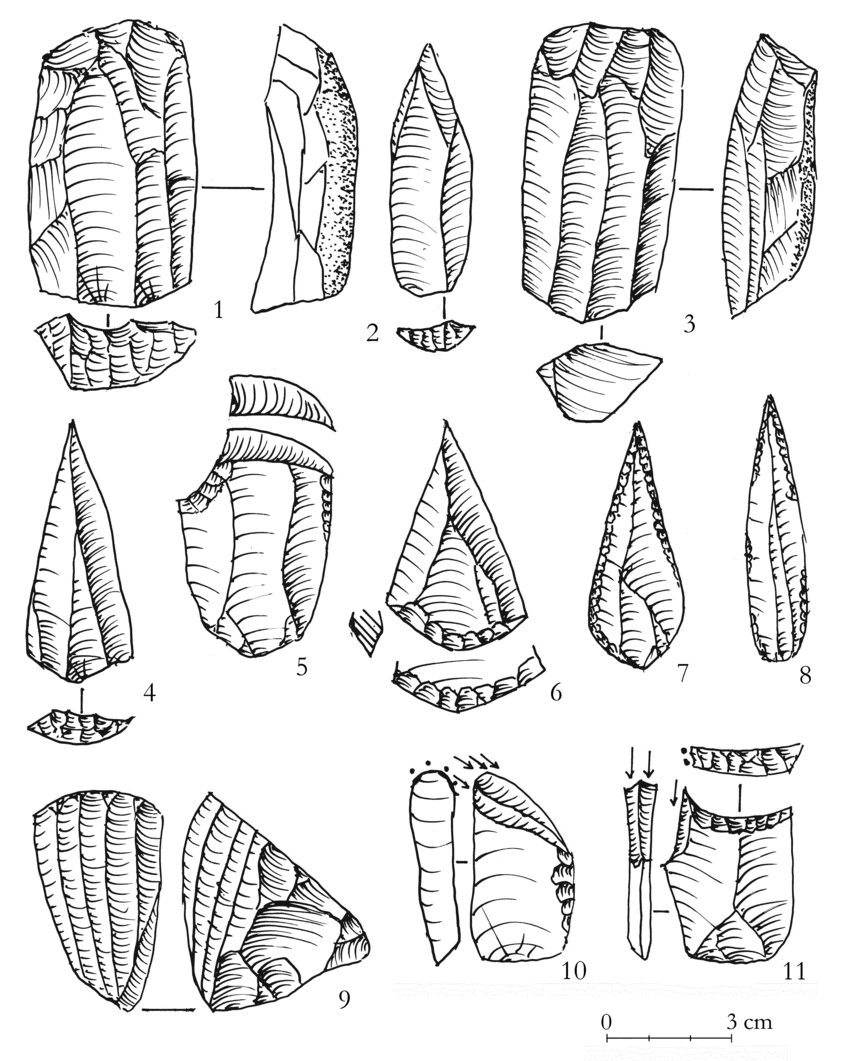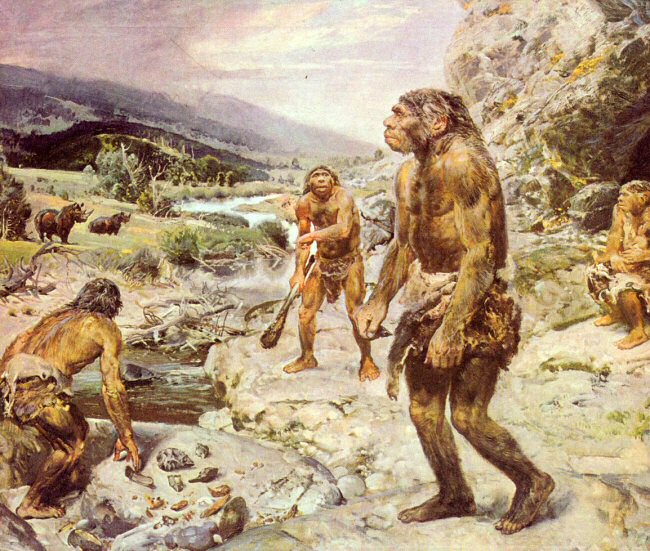The Palaeolithic Age in India is divided into three phases according to the type of stone tools used by people and also according to the nature of climatic change.
- Early or Lower Palaeolithic (500,000 – 150,000 BC)
- The Middle Palaeolithic 150,000 – 35,000 BC
- The Upper Palaeolithic (35,000 – 10,000 BC)
Lower Palaeolithic Age

The Early Old Stone Age may have begun in Africa around two million years ago, but in India, it is not older than 500,000 years. The first stone tool fabrication started and was called the Oldowan tradition which refers to a pattern of stone-tool manufacturing by Hominid (Homo habilis).
Splintered stones called eoliths have been considered one of the earliest tools. People used hand axes, cleavers, and choppers. The axes that were found in India are more or less similar to those of western Asia, Europe, and Africa. Stone tools were used mostly for chopping, digging, and skinning. The population largely preferred to live near the water source because the stone tools are abundant near the river valleys.
Important Sites: Lower Palaeolithic sites have been found in the Son (or Sohan) river valley in Punjab, now in Pakistan. Several other sites have been found in Kashmir and the Thar Desert.
Belan valley in UP and Didwana in Rajasthan is one of the major sites where tools related to this age were discovered. More than 2000 tools were discovered in Chirki-Nevasa in Maharashtra.
Nagarjunakonda in Andhra Pradesh and Bhimbetka near Bhopal show features of the Lower Palaeolithic age. The people of the Lower Stone Age seem to have principally been food gatherers and hunters. They lived also on fish and birds. The Early or Lower Stone Age in India may be associated with people of the Homo sapiens group.
Middle Palaeolithic Age

The Middle Palaeolithic Age was largely based upon flakes or small pieces of stone that have been found in different parts of India with regional variations. The principal tools comprised blades, points, borers, and scrapers, all made of flakes. The geographical horizon of the Middle Palaeolithic sites coincides with that of Lower Palaeolithic sites.
The artifacts of the Middle Palaeolithic age were found at several places on the bank of River Narmada, and south of the Tungabhadra River. The Belan valley (UP) is rich in stone tools and animal fossils including cattle and deer. These remains are related to both the Lower and Middle Stone Ages.
Upper Palaeolithic Age

There are 566 sites in India marked as Upper Palaeolithic sites. The climate was less humid, coinciding with the last phase of the ice age when the climate became comparatively warm. This era marks the appearance of new flint techniques and men of the modern type (Homo sapiens).
In India, the use of blades and burins was noted and it was found in Andhra Pradesh, Karnataka, Maharashtra, central MP, southern UP, Jharkhand, and adjoining areas. Caves and rock shelters for use by human beings in the Upper Palaeolithic phase have been discovered at Bhimbetka. An Upper Palaeolithic assemblage, characterized by comparatively large flakes, blades, burins, and scrapers has also been found in the upper levels of the Gujarat dunes.
Previous Year Questions for UPSC Prelims
Ques 1: Which of the following pairs is correctly matched?
a. Lower Palaeolithic – Tools made on flakes and blades
b. Middle Palaeolithic – Tools made on flakes
c. Upper Palaeolithic – Handaxe and cleaver industries
d. All of the above
Answer: Option C
Explanation: The Palaeolithic Age in India is divided into three phases, based on tool technology. These phases are:
(i) Lower Palaeolithic- Handaxe and cleaver industries
(ii) Middle Palaeolithic- Tools made on flakes
(iii) Upper Palaeolithic- Tools made on flakes and blades
Ques 2: Consider the following statements regarding the tools of the Lower Palaeolithic culture:
I. The main tool types in this phase were hand axes and cleavers, along with chopper-chopping tools.
II. The stones were made both on cores as well as flakes.
III. The raw materials used for making these stone tools ‘are various kinds of stone, like quartzite, chert, and sometimes even quartz and basalt, etc.
Which of the following statement(s) is/are correct?
a. Only I
b. I and II
c. II and III
d. All of the above
Answer: Option D
Explanation: The main tool types in this phase were hand axes and cleavers, along with chopper-chopping tools. They were made both on cores as well as flakes.
Lower Palaeolithic sites are of several types: habitation sites (either under rock shelters or in the open; factory sites associated with sources of raw materials; sites that combine elements of both these functions; and open-air sites in any of these categories subsequently. The raw materials used for making these stone tools ‘are various kinds of stone, like quartzite, chert, and sometimes even quartz and basalt, etc.
Ques 3: Which of the following sites belongs to the Lower Palaeolithic cultures?
a. Pahalgam
b. Belan valley
c. Bhimbetka
d. All of the above
Answer: Option D
Explanation: Some of the important sites of Lower Palaeolithic cultures are Pahalgam in Kashmir, Belan valley in Allahabad district (Uttar Pradesh) Bhimbetka and Adamgarh in Hoshangabad district, (Madhya Pradesh), 16 R and Singi Talav in Nagaur district (Rajasthan),
Nevasa in Ahmadnagar district (Maharashtra), Hunsgi in Gulbarga district (in Karnataka), and the famous site of Attirampakkam (Tamil Nadu).
Quick Questions on Palaeolithic Age for UPSC Preparation
What is known as Paleolithic Age?
Paleolithic Period, often known as the Old Stone Age, was an ancient technical or cultural period highlighted by the usage of crude tools made of chipped stone. The earliest people created basic pebble tools and crude stone choppers during the Lower Paleolithic (between 2,500,000 and 200,000 years ago).
Why is the Palaeolithic age so called?
Palaeo means Old and Lithic means Stone. Hence, Palaeolithic age refers to Old Stone Age.
What is the Paleolithic Age in simple words?
An era of prehistory known as the Palaeolithic (or Paleolithic) saw the invention of stone tools by humans. The Stone Age began at the beginning and lasted the longest. Between 3.3 million and 11,650 years ago, it started and stopped. The Palaeolithic period encompasses approximately 99 percent of human history.
When did Paleolithic Age end?
When the Neolithic Period started, the Paleolithic Period came to an end. This turning point is hotly contested, though, because the Neolithic stage was attained in various parts of the world at various dates. The widespread consensus is that it happened somewhere around 10,000 BCE.
Why Paleolithic art was created?
It is thought that the Stone Age peoples were making an effort to use magic or ritual to exert some type of control over their environment. This period’s art illustrates a significant advance in human understanding known as abstract thinking.
What is Paleolithic and Neolithic Age?
Prehistory’s Paleolithic Era, often known as the Old Stone Age, lasted from roughly 2.6 million to about 10,000 years ago. In many regions of the world, the Neolithic Era (or New Stone Age) began around 10,000 BC and came to an end between 4500 and 2000 BC. Paleolithic people travelled widely as small groups.
What are the 4 types of Paleolithic Art?
There are four primary categories of Stone Age art, as defined by archaeologists: pictographs (pictorial imagery, ideomorphs, or symbols), which includes cave painting and drawing, are a subcategory of petroglyphs (cupules, rock carvings, and engravings); and ancient sculpture

